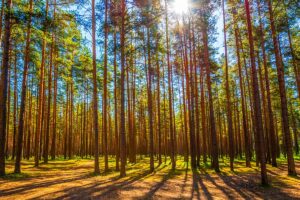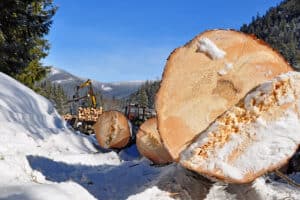(Part I of this series presented a sample cruise that will be referred to in this column.)
The seller of a timberland tract may be tempted to overstate the extent and value of his stumpage. Some foresters working for such sellers have been known to structure cruise information. In Parts II and III, I discussed six ways of doing this, and here are several others.
7. Inflate price multipliers. It’s very hard for a timberland buyer to detect a little inflation of species and pulp prices that are used in the seller’s cruise to value volume. The buyer’s forester will immediate notice a price multiplier that’s wildly out of sync, say red oak priced at $500/1000bf when prices have been stuck in the $300-to- $350 range for the last 18 months. If there’s a lot of veneer tucked into that red oak sawtimber volume, then the higher price might be justified, but the chances are it’s simple price pumping.
A hard-to-detect practice increases the price multiplier by something less than 10 percent. If an honest pricing would put the value of timber on a tract at $1,000,000, a modest 5 percent inflation in multipliers, adds $50,000 of dollars that timber buyers won’t pay in the current market. Five percent overvaluing would probably be considered in the acceptable range of market fluctuation…and not raise an eyebrow. Since stumpage prices normally fluctuate, only a consulting forester who’s been tracking species prices in that market will be able to catch this type of inflation.
An unintentional inflation of current value can occur with an old cruise. Stumpage prices track lumber demand and other macro-economic indicators. Stumpage prices were much higher three years ago than today. A three-year-old cruise, honestly done, could easily be 50 percent of more too high in today’s market. A timberland buyer wants to look at a current seller cruise, not one done months ago.
8. DBH cruise vs. stump cruise. Most cruises are done in terms of DBH, that is, diameter measured at 4.5 feet above the ground on the uphill side. Each scale’s formula accounts for the 4.5 feet between the ground and breast height; it’s not lost.
A cruise using the “point of severance” not DBH adds cruise volume by counting smaller trees that probably should not be cut. A 16” stump cruise, or point of severance cruise, translates roughly into a cruise that would include all trees 12” DBH and larger, because trees splay at their base (stump). Or put differently, a 12” stump cut might superficially sound the same as a 12” DBH cut, but it would actually drop down to 8” DBH. That’s a very, very hard cut. And in terms of the cruise, premerch volume in the 8 to 12” DBH cells is falsely counted as sawlog value. Timber buyers know the difference between a stump cut and a DBH cut; they will not value the small sawtimber as fully priced, 12”+ sawlogs.
If timberland buyers hear or see the words “point of severance,” “stump cruise” or “stump cut,” be on guard. Have your forester explain what it means in terms of expected sale value.
9. Hypothetical pulp value. In some locales, pulp volume may have a theoretical value but not an actual market value. If pulp prices are very low, it may not be economically worthwhile for a buyer/logger who has bought the timber to cut and haul the pulp logs to a mill. If mills are not buying pulp, timber buyers will not pay a landowner for pulp volume. I’ve had the experience of a logger leaving all pulp volume either on the ground as slash (tree tops) or standing, because it was not worth his effort to cut and haul them to a yard eight miles away.
A timberland buyer cannot act as if there will be a real market for both hardwood and pine pulp; he has to check each individually as close to the harvesting as possible to determine whether they will have value or just left in place.
10. Overly broad categories. Sometimes, a cruise properly lumps all hardwoods into a single category and all pine into a single category and uses a straight-through price multiplier for each volume. These cruise aggregations usually involve clearcuts for pulp or other fiber-based uses.
It’s easy to put too high a price multiplier on two such broad categories. A natural tract will typically contain several species in both categories.
A buyer may find opportunity in a seller’s cruise of this type by having his own forester disaggregate species by diameter class and value them individually, divided into pulp and sawlogs. A more disaggregated analysis will be able to price volume by separate markets, and net out more money for the timber seller in most instances.
The volume and values of planted pine stands are readily verified by the buyer’s consulting forester. Planted-pine stands are valued by acreage, age, quality, volume, end products, species and other factors. Other things being equal, planted pine stands provide fewer opportunities for deliberate over-estimating volume and overvaluing in a cruise.
11. Combination. Cruises that are cranked to benefit the seller frequently draw in several of the approaches described above. Cheating a little in four or five ways is harder for a timberland buyer to see and understand than cheating big in one dimension.
A final thought. I have met and worked with numerous absolutely honest foresters. They call volumes and values the same way whether they’re working for buyers or sellers and would not intentionally engage in the practices I’ve described.
I’ve also run into their opposite.
Honest consulting foresters hate inflated cruises. They diminish their profession and the integrity of straight-down-the-middle foresters.
Buyers must protect themselves against sellers who pressure foresters to produce cruises that misstate timber reality or lead buyers in that direction. The best defense, of course, is for a timberland buyer to hire an experienced forester to review whatever data and information the seller provides.
If a seller hands a buyer a cruise, the buyer should take it to a consulting forester of his choice for review. An experienced eye sees most of the baloney quickly. The buyer’s forester might offer a quick opinion on the order of “discount the volume by 25 percent and the dollars by 40 percent.” In some instances, a buyer should ask his forester to do either a walk-through evaluation or a cruise, depending on the circumstances, to obtain an accurate evaluation of the property’s timber.
Buyers can find consulting foresters through the Association of Consulting Foresters, Society of American Foresters, and foresters registered with each state.
This content may not be used or reproduced in any manner whatsoever, in part or in whole, without written permission of LANDTHINK. Use of this content without permission is a violation of federal copyright law. The articles, posts, comments, opinions and information provided by LANDTHINK are for informational and research purposes only and DOES NOT substitute or coincide with the advice of an attorney, accountant, real estate broker or any other licensed real estate professional. LANDTHINK strongly advises visitors and readers to seek their own professional guidance and advice related to buying, investing in or selling real estate.









The most inflated cruises I have ever seen were from forestry “consultants”. Consultants never put their own money on the line to buy timber, therefore, some are not as familiar with log specs and prices. I am a RE broker and proffessional forester/ timber buyer in SC. I am very familiar with cruises. A cruise is an opinion from the forester based on data collected and market conditions. Just like land value appraisals vary on the same property, cruises on the same timber may be very different due to the opinion and data collected. When its 100 degrees, your covered with ticks and chiggers, and you just saw a copperhead it’s hard to get accurate data. Timber is tough to estimate and sometimes even timber buyers loose on timber they buy due to what you call a “bogus cruise”. When selling timber, get quotes from at least three local timber buyers. When buying land, use your due dilligence time to contact local timber buyers and consultants to get there opinions.